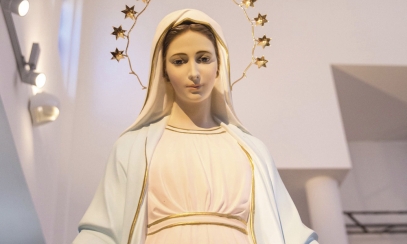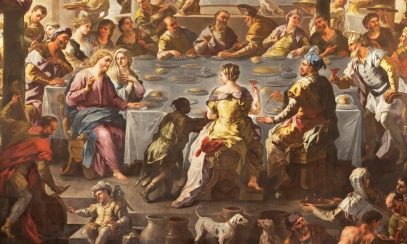The Traditional Latin Mass
Imagine you were in the eternal city when the Church of Rome decided to change the liturgical language from Greek to Latin. Most likely, there were people quite upset about this change, just as there have been people upset about the adoption of a new form of the Mass after the reforms of Vatican II. (Were he alive, here is where the Catholic game show host, Alex Trebek, might jump in and ask a tricky Jeopardy question: What remnant of Greek still remains in our current Mass? The answer appears below.)
Imagine you were in the eternal city when the Church of Rome decided to change the liturgical language from Greek to Latin. Most likely, there were people quite upset about this change, just as there have been people upset about the adoption of a new form of the Mass after the reforms of Vatican II. (Were he alive, here is where the Catholic game show host, Alex Trebek, might jump in and ask a tricky Jeopardy question: What remnant of Greek still remains in our current Mass? The answer appears below.)
At times, Catholics can find themselves a bit bewildered not only by changes in the Mass, but also by liturgical tensions within the Church. Currently, for instance, there are passionate views on both sides of the Traditional Latin Mass issue. With a hope of fostering more compassion and understanding around this issue, I would like to offer a few perspectives in the spirit of “taking the long view,” while being mindful of St. Ignatius of Loyola’s advice: “Every good Christian ought to be more ready to give a favorable interpretation to another's statement than to condemn it.”
What is the “Traditional Latin Mass”?
This term generally refers to the Eucharistic Liturgy celebrated using the 1962 Roman Missal. Other ways of referring to this liturgy are “the extraordinary form of the Roman Rite,” “the Tridentine Mass,” and the “usus antiquior” (Latin for “the more ancient usage”). In the Traditional Latin Mass, among other things, the priest faces the altar, and Latin is used throughout. After the reforms of Vatican II, the Latin Rite of the Catholic Church adopted a new Mass (called the “Novus Ordo”) in which the priest faces the people, and which allows modern languages to be used. A goal of the reforms at Vatican II was to promote “full, active and conscious” participation in the liturgy.
Beginning in 2021, Pope Francis has placed a number of restrictions on the celebration of the Traditional Latin Mass after Pope Benedict XVI had given wide permission for its use throughout the Church. The pre-Vatican II Mass is still permitted to be celebrated in some cases, however, as long as the necessary permissions are granted. Pope Francis explained that behind the restrictions was his desire to lift up in the Church, “in the variety of so many languages, one and the same prayer capable of expressing her unity.” One of the chief responsibilities of a pope is to safeguard the unity of the Church, and this is clearly the Holy Father’s intent. He has also expressed concern that some (not all) devotees of the Traditional Latin Mass may be causing a degree of division in the Church.
Hearing “the Voices on the Margins”
When Pope Francis initiated the synodal journey for the Catholic Church in 2021, he called for the Church to especially focus on listening to the voices of people who are on the peripheries. Somewhat ironically, those who find spiritual fulfillment in the Traditional Latin Mass can feel themselves more marginalized given the recent restrictions, and therefore they become one of those groups to whom the Church is called to show special pastoral concern. This includes listening to their voices. I have only attended one Traditional Latin Mass (in 1996…during my lay mission service in Austria). However, I do hear from devotees of the older Mass from time to time who share how much they experience a sense of divine transcendence in this liturgy. They also take note that many young people and young families feel attracted to the Traditional Latin Mass.
Recently, a young actor who played St. Padre Pio in a film said he converted to Catholicism in large part because he had to learn how to celebrate the pre-Vatican II Mass as part of his role. Comparing his experience of the older liturgy to the Novus Ordo, Shia LaBeouf stated that the “Latin Mass affects me deeply…because it feels like they’re not selling me a car.” Recently, I was struck by an article in the magazine, America, in which a member of the LGBTQIA+ community shared how meaningful the Traditional Latin Mass is for a number of Catholics who struggle with same-sex attraction – noting how the older Mass provides a reverent still point in their lives and a profound experience of the beauty of God.
Taking the Long View
On the website of the United States Conference of Catholic Bishops, you can find the words a young Fr. Ken Untener wrote in his famous reflection, Prophets of a Future Not Our Own: “It helps, now and then, to step back and take a long view.”
With regard to the debate around the Traditional Latin Mass, “the long view” comes to mind in these ways...
1. When Jesus walked the earth, he said: “If you love me, you will keep my commandments” (Jn 14:15). The Lord therefore connects obedience to love, which is the highest virtue. He also pointed to St. Peter, the first pope (and the other apostles), saying: “He who hears you hears me.” Obedience is not a very popular word these days, but our love for Christ and his Church does call us to obey – even when it is hard. (The four major documents of Vatican II actually touch on obedience 25 times.) Therefore, if we look at things through the eyes of the Lord, the current restrictions on the Traditional Latin Mass can be received with a spirit of loving obedience rather than protest. It’s also important to follow the example of our faithful bishops who, even if they have personal opinions that differ, still obey Pope Francis’ decisions in these matters.
2. The Church is a garden, not a monolith. There are more than 20 different liturgical expressions (called “rites”) that are all 100 % Catholic, such as Byzantine, Maronite, Syro-Malabar, etc. Although many of us tend to think only in terms of the Latin Rite, the Catholic Church therefore actually has great liturgical diversity alongside her essential unity. The challenging aspect with the Traditional Latin Mass is that it was in use prior to the recently established “Novus Ordo” Mass within the same Latin Rite. Clearly, the Holy Father has concerns about having the older Mass in some sense competing with the Vatican II Mass.
3. In Church history, we see that liturgies do change, although the essentials of the Mass remain the same. There is nothing eternal about any one particular liturgy or liturgical language. Only the heavenly liturgy is eternal. We also know that “the ecclesial pendulum” tends to swing somewhat under the leadership of different popes. Through it all, God calls us to pray for our Church leaders while keeping focused on Christ and the essentials of our faith. This is not always easy, and we need God’s grace to maintain a Christian spirit.
I referenced St. Padre Pio earlier. It strikes me that he might be a good patron for those who are disappointed about the recent restrictions on the Traditional Latin Mass. After receiving the mystical gift of the stigmata (bearing wounds on his body similar to those of Christ), Padre Pio was viewed with suspicion by some Church authorities. He was stripped of most of his priestly faculties – only permitted to celebrate Mass privately. What was the saint’s response? Humility and loving obedience to the decisions of Church authorities. When a mob protested the Church’s restrictions, the saint wrote to his local bishop, distancing himself from the group’s spirit of anger and disobedience. And just as Christ’s obedience in accepting the pain of the cross resulted in a great good (our salvation), so Padre Pio’s obedience brought tremendous fruit in his future ministry as a priest.
During my lay mission years in Nigeria, I used to hear the children sing an old hymn with this refrain: “Trust and obey, for there's no other way / to be happy in Jesus, but to trust and obey.”
In the end, we would all do well to follow this advice, while reciting that ancient Greek prayer for a merciful healing of the current liturgical discord:
Kyrie, eleison
Christe, eleison
Kyrie, eleison
Dr. Dan Osborn is the Diocesan Theologian and Coordinator of Permanent Diaconate Formation & Ministry for the Diocese of Saginaw.



